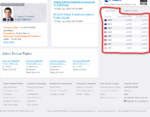Hi Jason Rogers,
Thanks for the information. I just need a bit of clarification about a few things.
Firstly, I am a little confused about the nature of DMA spread betting. I understand that when you are trading with a market maker that you are trading directly with/against the broker, but, from what you have said, that with FXCM you trade directly against the market?! I have heard the phrase DMA with a spread betting wrapper bandied about in this forum. Is this what FXCM do, and what does this actually mean in practice? Could you give an example of the trade process from start to finish.
Secondly, with regard to rollover; are you saying that there is no additional charge and that you only pay the LIBOR overnight rate, and not a markup of N%, which brokers usually charge? Also, do trades rollover naturally on the FX side of things, or do FXCM close the trade and then reopen the trade at current market rates?
Thirdly, I forgot to ask what FX data feed provider(s) do you use and is there an associated cost?
Thanks again.
LBP
Hi LBP,
The phrase you heard is correct in how it applies to FXCM. The spread bet accounts are simply the regular standard accounts offered by FXCM with the spreadbet wrapper. The spreadbet designation gives the advantage to UK traders of having a special tax-free status.
What distinguishes NDD (or STP and DMA) from a market maker is how the trade is offset once it reaches the broker. A market maker aggregates client positions and then manages the risk as it sees fit. If the positions are not hedged with their bank relationships, it means the broker could profit from trader losses and vice versa. With NDD forex execution, each order is hedged individually with oneo f multiple liquidity providers. I'll give you an example from start to finish of how this works.
How are the forex quotes determined?
FXCM receives pricing and liquidity from 10+ liquidity providers. As the liquidity providers stream their pricing to FXCM, our best bid best offer execution engine sorts the prices and displays the best bid/ask on the trading platform with a pip mark-up. Here’s a short example of how it works using two banks and without fractional pips to make things simple.
Let’s suppose Bank A and Bank B are each quoting prices for GBP/USD. Here’s what each bank is quoting.
Bank A: 1.5625 x 1.5627
Bank B: 1.5624 x 1.5626
The best price being offered by the banks on the sell side (you sell and bank buys) is at 1.5625 by Bank A, and the best price being offered by the banks on the buy side (you buy and bank sells) is at 1.5626 by Bank B. Therefore the bid/ask is 1.5625/1.5626. There’s a 1 pip spread between the buy and sell price. FXCM then adds a fixed mark-up which is our compensation. Assuming there is a mark up of 1 pip added to the bid/ask, the final price displayed on the FX Trading Station would be 1.5624/1.5627. You then see a 3 pip spread.
This process is occurring very quickly and with 10+ separate feeds to sort through. The price competition among the liquidity providers means that you see the best bid/ask spread plus mark-up currently being offered.
How does NDD work once you place the trade?
Continuing with the previous GBP/USD example, let’s say you want to buy GBP/USD and decide to click on the price 1.5627. When you submit the order, the order is sent to FXCM for the price 1.5627 and FXCM routes the order to Bank A offering to sell at the price 1.5626. If the order is accepted, Bank A has a short position at the price 1.5626, you have a long position at the price 1.5627, and FXCM has gained 1 pip in revenue. Each order is offset individually in this fashion. The trades are not aggregated like you would have with a market maker so at no point is FXCM taking on the risk of trading against clients as a market maker or dealing desk would.
If the market continues to rise, your long position becomes more profitable and the banks short position turns into a loss, and vice versa. If you close the trade at a $200 profit, the liquidity provider is booked with a $200 loss. If you have a $200 loss, the bank has a $200 profit. NDD forex execution eliminates the risk of traders being profitable, and eliminates the conflict of interest whereby it’s in the best interest of a dealing desk for its clients to lose.
We have also put together a video that goes over this process in video format.
FXCM's No Dealing Desk Advantage for Forex Trading - YouTube
Secondly, rollover for forex transactions apply if you hold a position open at 22:00 GMT, and you can either earn or pay rollover depending on the currency pair held. Rollover is accounted for separately in the "Roll" column of the open positions window rather than closing and re-opening trades as some brokers may do. This makes it more transparent for you to keep track of what you are earning or paying for rollover. More details on forex rollover along with an example of where to find the rollover amounts in the dealing rates window can be found here
http://www.dailyfx.com/forex/education/learn_forex/using_dailyfx/fundamentals/2010-01-19-2142-Understanding_Foreign_Exchange_Rollover.html .
Lastly, FXCM's FX data feed is comprised of the 10+ liquidity providers streaming prices to FXCM, and there is no cost associated with having the feed.
Whew, that was a long post
🙂 Hope it helps.
Jason



